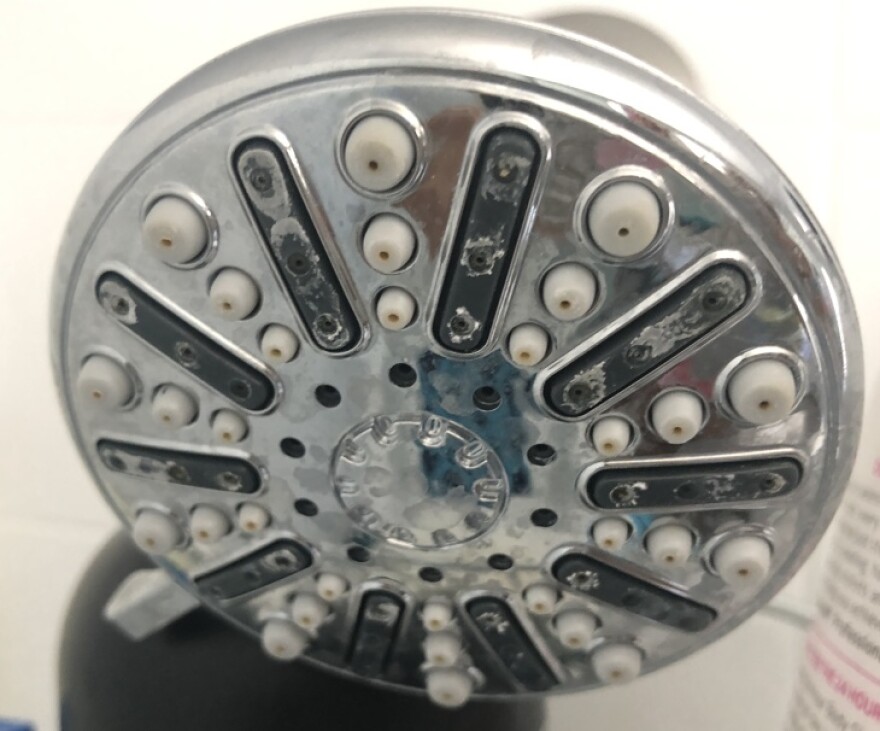Truth matters. Community matters. Your support makes both possible. LAist is one of the few places where news remains independent and free from political and corporate influence. Stand up for truth and for LAist. Make your year-end tax-deductible gift now.
Dear LAist: Why Does LA Tap Water Seem To Cause More Calcium Build-Up?

WE'RE ANSWERING THE QUESTIONS ABOUT SOUTHERN CALIFORNIA THAT KEEP YOU UP AT NIGHT. IF YOU HAVE ONE, ASK IT HERE.
When you think about Los Angeles water, what usually comes to mind? The shady history of how the complex system came to be? Or maybe it's the recent headlines about how certain districts in charge of providing water to local communities have been falling short.
Regardless, one thing to note is that L.A.'s water system is big and convoluted and we're going to attempt to scratch the surface. A KPCC/LAist listener asked: Why does the tap water have such high levels of calcium? Is the water like this in all of Los Angeles County? Let's dig in.
FIRST, SOME CONTEXT
The question came following an observation by listener Daniela Garcia. She was born and raised in South Gate and growing up she noticed something about her water nozzles: calcium build-up. Or more specifically, calcium carbonate, that chalky filmy white residue water leaves behind on faucets and shower heads.
"But then when I went to college in Massachusetts and now I live in New York City, I see that that's not an issue here," Garcia said. "That kind of made me curious to want to know if that's something that's, a unique situation to Los Angeles or Southern California or even if that varies within cities in L.A. County."
Garcia's question has two parts. The first focuses on water in the city of L.A. and the second focuses on the county. Let's tackle the city first.

L.A.'s water comes to the city from many different sources and it's those sources that can determine just how much calcium carbonate makes its way to your faucet. If you're living in the city, your water is most likely a cocktail from these sources:
- The Los Angeles Aqueduct - It's about 419 miles in length, beginning in Owens Valley and ending in Granada Hills.
- The State Water Project - Collects water from Northern California rivers and redistributes through various aqueduct systems. It's responsible for about 70% of our water.
- Colorado River Aqueduct (purchased water) - Has a length of 242 miles and is managed by the Metropolitan Water District of Southern California.
- Stormwater capture, local groundwater, recycled water and conservation.
"Mix calcium with oxygen and we get calcium carbonate," explained Dianna Jones, manager of regulatory affairs and consumer protections for LADWP, "and it's naturally occurring in the environment and in drinking water and it's the way that we measure the hardness of the water."
A water's "hardness" means its mineral content. When it makes its way to L.A., your tap water likely seeped through deposits of limestone and chalk which are largely made up of calcium and magnesium.
According to Jones, the most calcium carbonate rich water comes from groundwater sources and the Colorado River Aqueduct. And as this graphic shows, Central and Harbor communities get their water from that source.
"The Silverlake/Downtown and south Los Angeles area would have the highest level water hardness and also in our East Los Angeles area, those numbers are large amounts as well," Jones said.

WIDENING THE LENS TO LA COUNTY
TL;DR: more often than not, groundwater and water from the Colorado Aqueduct are richer in minerals and are therefore "harder," with higher levels of calcium carbonate.
On the flip side, water from the State Water Project, which comes from rivers up in northern California, is usually lower in minerals and therefore "softer."
When it comes to L.A. County's water, like LADWP, the Metropolitan Water District's sources are also a mixed bag. The agency is an importer and they bring in water from:
- Northern California through the Sacramento-San Joaquin Delta via the State Water Project
- Colorado River through its Colorado River Aqueduct
"Those two sources of water are very different in terms of the mineral content," said Mic Stewart, water quality expert at MWD. "We do know that water from Northern California that we get from the State Water Project has about half the levels than we'd see at the Colorado River water."
However, Stewart explains, it's not all about the source -- it also has to do with the water's journey to your faucet.
"From groundwater site to groundwater site in California, it really depends upon the particular aquifer that water is set in in terms of minerals in there," he said.
CONCLUSION: LA'S WATER IS WONKY
So, does water carry the same amounts of calcium carbonate throughout L.A. County? No, the amount of varies depending on where you live and the minerals your water picked up on its journey to your faucet. And looking at the city, it's a similar deal; the water is a rich cocktail that comes together from many different sources throughout the state.
And we should note that calcium carbonate is harmless -- other than providing you with some extra scrubbing work on those faucets and shower heads. But if it bothers you, we suggest investing in a water softner.
Editor's note: Listen to the radio version of this story here on KPCC's Take Two.
If you have another question to ask LAist, leave it here.
Hey, thanks. You read the entire story. And we love you for that. Here at LAist, our goal is to cover the stories that matter to you, not advertisers. We don't have paywalls, but we do have payments (aka bills). So if you love independent, local journalism, join us. Let's make the world a better place, together. Donate now.







